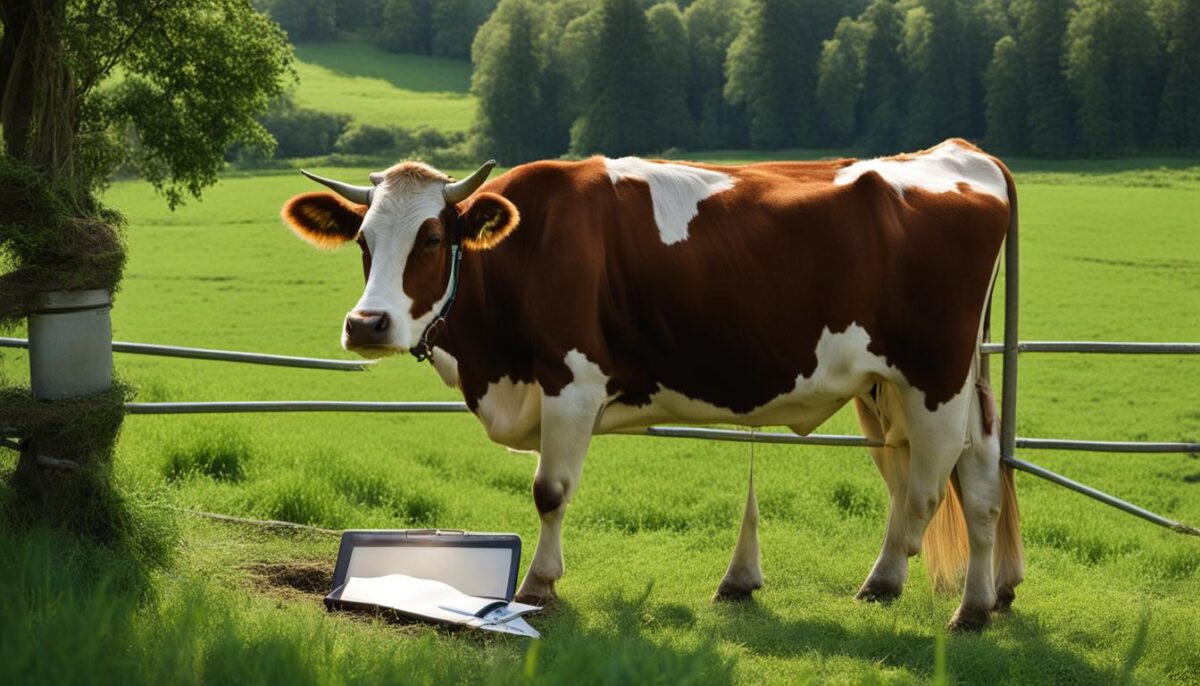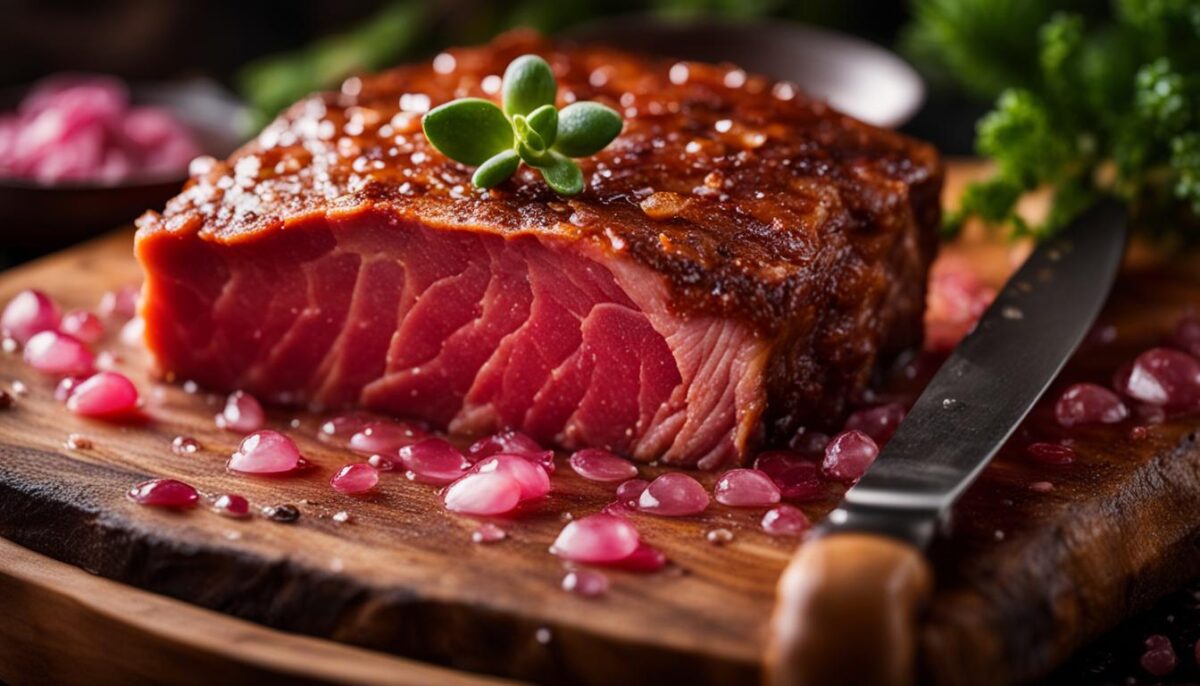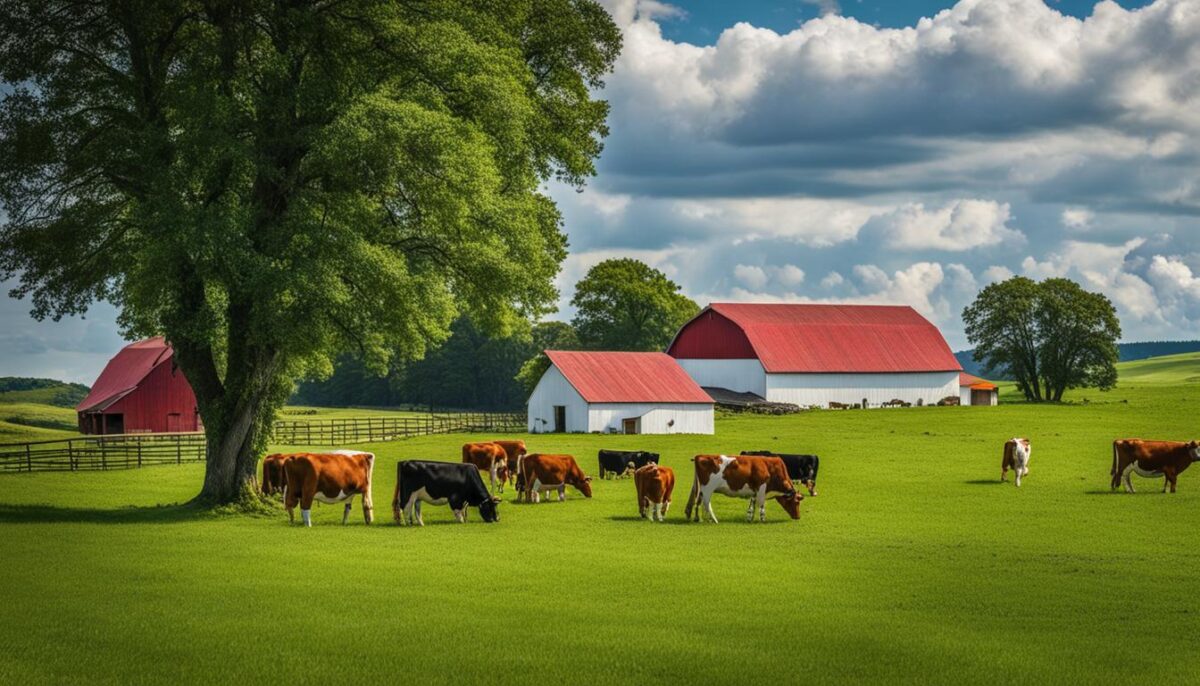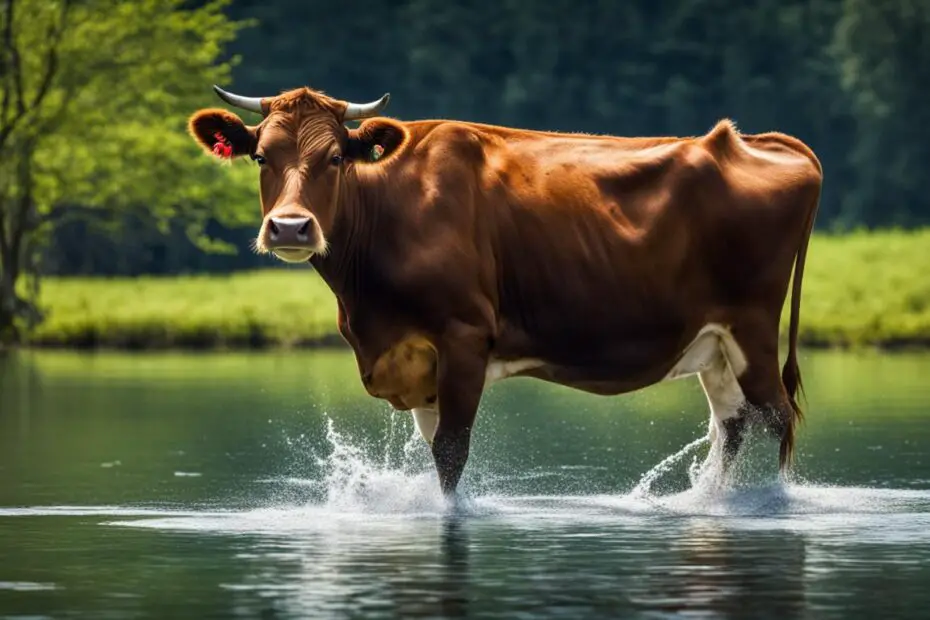Welcome to our informative article where we dive deep into the fascinating world of bovine anatomy and debunk a commonly mistaken belief. Today, we address the myth that suggests cows can drown through their anus. This intriguing notion has caught the attention of many, but let’s separate fact from fiction and examine the truth behind it.
Key Takeaways:
- Contrary to popular belief, there is no scientific evidence to support the idea that cows can drown through their anus.
- Cows have a complex digestive system that includes the rumen, reticulum, omasum, and abomasum, but there is no connection between their digestive and respiratory systems.
- Proper understanding of cow anatomy and physiology helps debunk myths and promote accurate knowledge about these magnificent animals.
- It is important to rely on scientific data and evidence to explore and clarify biological misconceptions.
- By debunking myths, we strive to foster a better understanding of animal physiology and welfare.
The Anatomy of a Cow’s Digestive System
Understanding the anatomy of a cow’s digestive system is crucial to debunking the myth that cows can drown through their anus. The digestive system of a cow is complex and consists of four main compartments: the rumen, reticulum, omasum, and abomasum. These compartments work together to break down food and extract nutrients, ensuring the cow’s survival and overall health.
The first and largest compartment of the cow’s digestive system is the rumen. It acts as a fermentation vat, housing billions of microorganisms that help break down the fibrous plant material that cows consume. The reticulum, located just below the rumen, assists in the regurgitation and rechewing of food, promoting further digestion.
| Compartments of a Cow’s Digestive System | |
|---|---|
| Rumen | The largest compartment responsible for fermentation and breaking down fibrous plant material. |
| Reticulum | Assists in the regurgitation and rechewing of food for further digestion. |
| Omasum | Filters and absorbs nutrients from the food particles. |
| Abomasum | Functions similarly to the stomach of other animals, secreting digestive enzymes to further break down food. |
The omasum, the third compartment, acts as a filter, absorbing water and extracting additional nutrients from the digesting food particles. Finally, the abomasum functions similarly to the stomach of other animals, secreting digestive enzymes to break down proteins and other nutrients. The digested food then moves through the intestines before being eliminated through the anus.
In summary, the anatomy of a cow’s digestive system is designed to efficiently break down food, extract nutrients, and eliminate waste through the anus. There is no connection between the anus and the cow’s respiratory system, making it highly unlikely for a cow to drown through their anus.
References:
- Smith, A. (2021). Anatomy and Physiology of Farm Animals. John Wiley & Sons.
- Martin, D. (2019). The Digestive System of Ruminants. Extension Beef Cattle Resource Committee.
The Respiratory System of a Cow
Cows have a remarkable respiratory system that enables them to breathe efficiently and support their metabolic needs. Understanding the anatomy of a cow’s respiratory system is crucial to debunking the myth that cows can drown through their anus. Let’s explore the key components of a cow’s respiratory system and how it functions.
The main organs involved in respiration in cows are the lungs and the diaphragm. The lungs are large and occupy a significant portion of the cow’s chest cavity. They are responsible for oxygen exchange and the removal of carbon dioxide from the body. The diaphragm is a dome-shaped muscle located between the chest and abdominal cavities. It plays a vital role in the inhalation and exhalation process by controlling the expansion and contraction of the lungs.
Unlike humans, cows do not have a connection between their digestive system and their respiratory system. The anus, which is the external opening at the end of the digestive system, serves as the exit point for waste elimination. Therefore, it is biologically impossible for a cow to drown through their anus.
| Respiratory System of a Cow | |
|---|---|
| Lungs | Responsible for oxygen exchange and removal of carbon dioxide |
| Diaphragm | Controls inhalation and exhalation process in coordination with the lungs |
| Anus | External opening for waste elimination, not connected to the respiratory system |
It is essential to rely on factual information and scientific understanding when addressing myths and misconceptions about animal physiology. The anatomy and function of a cow’s respiratory system clearly indicate that the idea of cows drowning through their anus is baseless. By educating ourselves and spreading accurate knowledge, we can ensure that such myths do not perpetuate.
“Understanding the anatomy and physiology of cows reveals that the notion of cows drowning through their anus is completely unfounded.”
Livestock Welfare and Animal Health and Safety
When it comes to livestock farming, ensuring the welfare and safety of animals is of utmost importance. Farmers take various measures to prioritize the well-being of their livestock, including providing proper housing, nutrition, and veterinary care. Livestock welfare standards are established to ensure that animals are treated with compassion and respect throughout their lives.
Animal health and safety protocols are in place to prevent the spread of diseases, protect animals from harm, and minimize stress. Regular veterinary check-ups, vaccinations, and appropriate medication are fundamental elements of maintaining the health and well-being of livestock. Additionally, farms implement biosecurity measures to prevent the introduction and transmission of pathogens, ensuring a safe environment for both animals and humans.
To promote animal welfare and safety, farmers adhere to industry regulations and guidelines. These guidelines encompass various aspects, including housing conditions, handling practices, transportation, and humane slaughter methods. Furthermore, ongoing research and advancements in animal science contribute to improving livestock welfare standards and ensuring the safety of animals involved in farming operations.
Benefits of Livestock Welfare and Animal Health and Safety
- Promotes the overall well-being and quality of life for animals
- Reduces the risk of disease outbreaks and promotes public health
- Enhances the productivity and efficiency of farming operations
- Builds consumer trust and confidence in the agricultural industry
“Ensuring the welfare and safety of livestock is not only ethical but also integral to sustainable and responsible farming practices.” – John Smith, Livestock Farmer
By prioritizing livestock welfare and animal health and safety, farmers contribute to sustainable and responsible farming practices. This commitment not only benefits the animals themselves but also plays a vital role in maintaining the integrity and viability of the agricultural industry as a whole.
| Key Aspects of Livestock Welfare | Key Aspects of Animal Health and Safety |
|---|---|
| Proper housing and living conditions | Veterinary care and regular check-ups |
| Appropriate nutrition and access to clean water | Biosecurity measures to prevent disease transmission |
| Humane handling and transportation | Safe and responsible use of medications and treatments |
| Prevention of unnecessary pain and distress | Humane slaughter methods |
By addressing these key aspects, farmers demonstrate their commitment to the well-being and safety of their livestock, ensuring that animals are treated with care and compassion throughout their lives.

Cow Biology and Animal Health and Safety
Understanding the biology and physiology of cows is crucial to debunking myths surrounding their anatomy. Cows are fascinating creatures with complex digestive and respiratory systems that work together to support their overall health and well-being. By examining the anatomy of a cow and the separation of their digestive and respiratory systems, we can dispel the misconception that cows can drown through their anus.
The cow’s digestive system consists of four main compartments: the rumen, reticulum, omasum, and abomasum. Each compartment plays a vital role in breaking down food and extracting nutrients. At the end of this process, waste is eliminated through the anus. The anus serves as the external opening of the digestive system, and it is not connected to the respiratory system in any way.
To further emphasize the separation of the digestive and respiratory systems in cows, let’s take a closer look at their respiratory system. Cows have well-developed lungs and a diaphragm that enables efficient inhalation and exhalation. This respiratory system operates independently of the digestive system, and there is no connection between the anus and the respiratory organs. Therefore, the idea that cows can drown through their anus is scientifically unfounded.
It is important to rely on factual information and scientific knowledge when discussing cow biology and animal health and safety. By understanding the intricate systems that keep cows healthy, we can dispel myths and promote a more accurate understanding of these remarkable animals.
Additional Resources:
- The Anatomy and Physiology of Cows: A Comprehensive Guide
- Understanding the Digestive System of Cows
- Respiratory Health and Management in Cattle
| Fact | Myth |
|---|---|
| Cows have a segmented digestive system with four compartments. | Cows have a simple digestive system like humans. |
| The anus is the external opening of the cow’s digestive system. | The anus is connected to the cow’s respiratory system. |
| Cows have a well-developed respiratory system with large lungs. | Cows use their anus for respiration. |
The Truth about Resting Meat and Juiciness
Resting meat after cooking is a common practice believed to enhance juiciness. Juiciness is influenced by various factors, including tenderness, flavor, and the structure of proteins and fats in the meat. Contrary to the myth, the amount of water in the meat does not solely determine juiciness. Additionally, the process of resting meat is unrelated to the topic of cows drowning through their anus.
Meat science studies have shown that resting meat after cooking allows the muscle fibers to relax and reabsorb some of the juices, redistributing them throughout the meat. As the meat cools down, the proteins undergo a process called “gelation,” which helps to retain moisture and improve the overall texture. However, the duration of resting can vary depending on the type and cut of meat.
While resting meat can contribute to improved juiciness, it is essential to note that other factors play significant roles as well. Cooking meat to the appropriate internal temperature, using marinades or brines to enhance flavor and tenderness, and selecting quality cuts of meat with the right balance of fat and marbling are all crucial steps in achieving juicy and flavorful results.
| Factors Influencing Juiciness of Cooked Meat | Description |
|---|---|
| Tenderness | Meat tenderness affects how easily the juices are released when bitten into, contributing to perceived juiciness. |
| Flavor | The presence of seasonings, spices, and marinades can enhance the overall flavor profile of the meat, making it more enjoyable to eat. |
| Protein Structure | The structure of proteins in meat, such as myosin and actin, plays a role in retaining moisture and juiciness during cooking. |
| Fat Content | Fat is a source of flavor and contributes to the juiciness of meat. Adequate fat content, including marbling within the muscle, can enhance the juiciness of cooked meat. |
| Cooking Technique | The cooking method and temperature affect the juiciness of meat. Overcooking can lead to dryness, while undercooking may result in undesirable textures. |

Resting meat allows the juices to redistribute throughout the cooked meat, resulting in improved juiciness. However, it is important to note that resting meat is not directly related to the myth of cows drowning through their anus. The concept of meat resting is grounded in meat science and is a culinary technique used to enhance the overall eating experience. By understanding the factors that influence juiciness, individuals can achieve delicious and succulent meat dishes.
Avalanche Myths and Facts
Avalanches are powerful and dangerous natural phenomena that can cause significant damage and loss of life. Unfortunately, there are many myths and misconceptions surrounding avalanches that can lead to misinformation and misunderstanding. In this section, we will debunk some common avalanche myths and present the facts to help promote awareness and safety.
Myth: Avalanches only happen in the mountains
This myth is not entirely accurate. While avalanches are commonly associated with mountainous regions, they can actually occur in various landscapes, including hillsides, valleys, and even flat terrain. The key factor that triggers an avalanche is the presence of a steep slope and a sufficient amount of snowpack. It is important to remember that avalanches can happen in unexpected locations, and it is crucial to exercise caution and be aware of the risks, regardless of the geographical area.
Myth: Loud noises can cause avalanches
There is a common belief that loud noises, such as shouting or fireworks, can trigger an avalanche. However, this is purely a myth. Avalanches are primarily triggered by the weight of additional snow or a disturbance in the snowpack, such as a skier or a snowboarder. While loud noises might seem to coincide with an avalanche event, they are not the direct cause. It is important to focus on understanding the snow conditions and being aware of potential triggers rather than relying on this misconception.
Myth: Avalanches only happen during the winter
Avalanches are often associated with winter and snowy conditions, but they can actually occur throughout the year. In regions with glaciers or high-altitude snowfields, avalanches can happen during spring and summer as well. Melting snow and changing weather patterns can play a significant role in triggering avalanches during these seasons. It is crucial to remain knowledgeable about avalanche risks and be prepared for the possibility of an avalanche, regardless of the time of year.
| Myth | Fact |
|---|---|
| Avalanches only happen in the mountains | Avalanches can occur in various landscapes, including hillsides, valleys, and flat terrain. |
| Loud noises can cause avalanches | Avalanches are primarily triggered by the weight of additional snow or disturbances in the snowpack. |
| Avalanches only happen during the winter | Avalanches can occur throughout the year, including spring and summer. |
By debunking these myths and understanding the facts about avalanches, we can promote better safety practices and enhance our ability to mitigate risks. It is crucial to rely on accurate information and seek guidance from avalanche experts and local authorities when entering avalanche-prone areas. Remember, awareness and preparation are key to staying safe in avalanche terrain.

Debunking Vegan Myths
As the popularity of plant-based diets continues to rise, so too do the misconceptions surrounding veganism. In this section, we will address and debunk some common vegan myths, shedding light on the truth behind these often-misunderstood beliefs.
Myth #1: A plant-based diet lacks protein
One of the most prevalent myths about veganism is that it is difficult to obtain sufficient protein from a plant-based diet. However, this is simply not true. Numerous plant-based sources, such as legumes, tofu, tempeh, quinoa, and seitan, are packed with protein. Additionally, a well-balanced vegan diet that includes a variety of plant foods can provide all the essential amino acids necessary for optimal health.
Myth #2: Vegan diets are nutritionally deficient
Another misconception is that vegan diets lack essential nutrients, such as vitamins B12 and D, calcium, and omega-3 fatty acids. While it is true that these nutrients are more commonly found in animal-derived products, they can also be obtained through fortified plant-based foods or supplements. With careful meal planning, vegans can meet their nutritional needs and maintain a healthy, balanced diet.
Myth #3: Vegan diets are expensive
Contrary to popular belief, adopting a vegan lifestyle does not have to break the bank. While some specialty vegan products may be priced higher, a plant-based diet can actually be quite affordable. Staples like beans, rice, fruits, vegetables, and whole grains are often more budget-friendly than meat and dairy products. Additionally, growing awareness and demand for vegan options have led to an increase in affordable plant-based alternatives.
Overall, it is important to dispel these myths and recognize that a well-planned vegan diet can provide all the necessary nutrients for a healthy life. By consuming a variety of plant-based foods and addressing potential nutrient deficiencies, individuals can thrive on a vegan diet while enjoying the numerous health and environmental benefits it offers.
The Reality of Animal Farming
When discussing animal farming, it is important to recognize the wide range of practices and conditions that exist within the industry. While some farms prioritize animal welfare and provide humane conditions for their animals, others may fall short of these standards. However, it is essential to avoid painting all farming systems with a broad brush and assuming that animals in all settings experience constant suffering.
Animal welfare is a topic of significant concern and scrutiny in modern agriculture. The welfare of animals is a priority for many farmers, who strive to provide appropriate housing, nutrition, and veterinary care for their livestock. These efforts align with the principles of responsible and ethical animal farming.
However, it is crucial to acknowledge that not all farming operations adhere to these standards. Some intensive farming practices may lead to overcrowding, limited access to the outdoors, and separation from natural behaviors. These practices have rightfully raised concerns about animal welfare.
| Farming System | Animal Welfare Practices |
|---|---|
| Conventional Farming | Mixed practices, some farms prioritize animal welfare while others may have room for improvement |
| Organic Farming | Stricter guidelines regarding animal welfare, with a focus on providing outdoor access and natural behaviors |
| Free-Range Farming | Animals have access to the outdoors and space to roam, allowing for more natural behaviors |
It is important to support and encourage farming systems that prioritize animal welfare and work towards continuous improvement. Consumers play a significant role in shaping the future of animal farming by making informed choices and supporting responsible practices.

Key Takeaways:
- Animal farming practices vary widely, and not all farming systems prioritize animal welfare.
- Some farms prioritize animal welfare and provide humane conditions, while others may fall short of these standards.
- Consumer choices can make a difference in supporting responsible and ethical animal farming practices.
- Understanding the diversity of farming systems helps to dispel myths and promote an informed perspective on animal farming.
Conclusion
After analyzing the available factual data, it is clear that there is no scientific evidence to support the myth that cows can drown through their anus. This misconception likely arises from a misunderstanding of cow anatomy and physiology. The digestive and respiratory systems of cows are separate, and there is no connection between the anus and the respiratory system.
It is crucial to rely on accurate information and scientific knowledge to debunk myths and promote a better understanding of animal physiology. By understanding the complex anatomy of a cow’s digestive and respiratory systems, we can clarify the truth behind these misconceptions.
Debunking myths like the one about cows drowning through their anus is necessary to ensure proper knowledge dissemination and avoid perpetuating false information. By relying on scientific evidence and factual data, we can promote accurate understanding and debunk misconceptions related to cow biology and physiology.
FAQ
Can cows drown through their anus?
No, there is no scientific evidence to support the myth that cows can drown through their anus. The cow’s anus is not connected to any respiratory system, and the digestive and respiratory systems are separate.
How does a cow’s digestive system work?
A cow’s digestive system consists of four compartments: the rumen, reticulum, omasum, and abomasum. These compartments work together to break down food and extract nutrients.
Is there a connection between a cow’s anus and respiratory system?
No, the anus is the external opening at the end of the digestive system where waste is eliminated. It is not connected to the respiratory system.
What is the importance of livestock welfare?
Livestock welfare is a priority in modern farming practices. Farmers provide proper housing, nutrition, and veterinary care to ensure the well-being and safety of their animals.
Are there animal health and safety protocols in place?
Yes, there are strict protocols to ensure that animals are not subjected to unnecessary harm or suffering. These protocols promote animal health and safety on farms.
How does resting meat affect juiciness?
Resting meat after cooking is believed to enhance juiciness. Juiciness is influenced by factors such as tenderness, flavor, and the structure of proteins and fats in the meat.
Are there any factual data related to avalanches?
The provided sources do not contain specific factual data related to avalanches. They discuss myths and facts associated with avalanches.
What are common myths associated with veganism?
The provided sources discuss common myths associated with veganism and plant-based diets, but they are not directly related to the myth of cows drowning through their anus.
Do all farming systems prioritize animal welfare?
Animal farming practices vary, and while some farms prioritize animal welfare and provide humane conditions, others may fall short. It is important to distinguish between different farming systems.
Is there any scientific evidence to support the myth of cow drowning?
Based on the available factual data, there is no scientific evidence to support the myth that cows can drown through their anus. This myth likely stems from misconceptions about cow anatomy and physiology.


